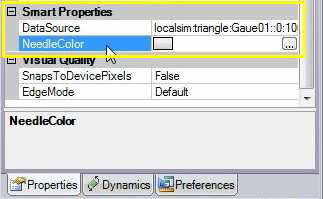Smart Symbols Quick Start
Smart Symbols are an enhanced version of object groups. They greatly simplify the configuration and save engineering time by allowing a configuration of properties of inner objects without a need to drill-into the symbol.
- Smart Symbols are groupings of graphical objects. They are created from object groups using a wizard, which simplifies the binding of smart properties to properties of the descendant objects.
- Similarly, to object groups, Smart Symbols can be stored in the Symbol Library and reused later.
- Smart Symbols appear as a special kind of object in the object Explorer.
- Smart Properties appear in the Property Pane in a section called Smart Properties.
- Smart Properties of Smart Symbols can be added, edited, and removed at any time.
Creating a Simple Gauge
- Open a new GraphWorX display by going to Start > All > Programs > ICONICS > GENESIS64 > GraphWorX64 > GraphWorX64.
- Create a circle using the Ellipse shape tool. Hold down the Shift key to draw a circle onto the canvase.
Create a Circle

- Inside the circle, create a polygon that looks like a needle (or just a vertical line for simple graphics).
Create a polygon

- Add a Process Point.
Insert a Process Point

- Select an OPC Tag for the Process Point. You can choose a simulated signal for this purpose.
-
Select the former created polygon (or vertical line) and choose “Rotation” from the “Dynamics” ribbon.
-
Change the Pivot point by dragging the red dot to the center of the circle you created at the beginning.
Change the Pivot Point

-
Define the start angle and end angle, either by entering the values in the dynamics pane or by dragging the shadow object of the needle to the start and end location.
Set Start and End Angle

-
Select the same OPC tag you chose for the Process Point as Data Source from the dynamics pane. This is important, as we want the same value reflected in the rotation as well as displayed in the process point.
Select Data Source

-
Select all objects (Circle, Polygon and Process Point) and group them using the group function on the Home tab of the ribbon.
Group Selected Objects

-
The group has become one object now. While the group object is selected, go to the “Dynamics” tab of the ribbon and select “Convert Symbol”.
Converting a Symbol

-
The smart symbol wizard pops up. Check the “Expose data sources as Smart Properties” option to make the Data Source a smart property. You can leave the second option unchecked.
Smart Symbol Wizard

-
Click OK to get to the next dialog. Here define the name of the exposed data source. In our case we want to rename “localsimtriangleGauge0101000100” to something more readable like “DataSource”.
Smart Properties

-
You have created a simple smart object. You can duplicate this object and change the data source by selecting a different OPC tag using the “DataSource” smart property, highlighted below.
Smart Properties DataSource

-
If you have your symbol library open, you can drag and drop your smart symbol to the library so that it is available to all your projects.
Adding a Smart Property
You can add smart properties to any smart symbol. In this section, we will detail how to expose the color property of the gauge needle created in the previous section.
- Having your smart symbol selected right-click on it and select “Edit Group”.
- Select the polygon. In the properties pane select “Fill” and right-click on it to bring up a menu. Select “Add to smart properties”.
Expose Properties as Smart Properties

- The Add Smart Property dialog comes up. Give this property a name; in the example we called it “NeedleColor”.
Define Property Name

- Browse to your Smart Symbol’s Smart Properties and you will see the newly added color property. Don’t forget to add this new Smart Symbol into your Library again. Whenever you use it, you can change its data source and the color of the needle by editing the appropriate smart property.
Added NeedleColor Property

See also: